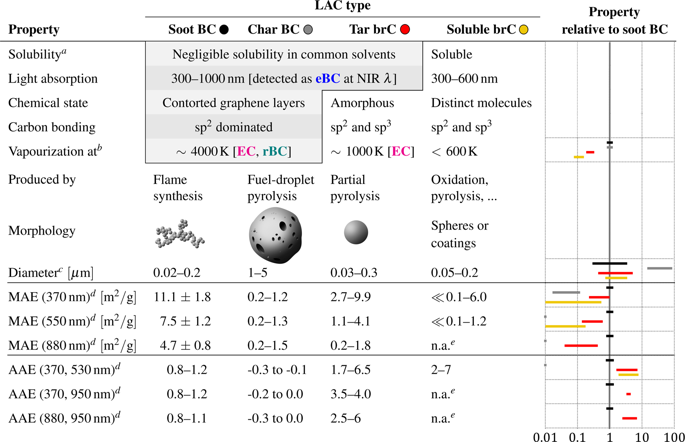npj Climate and Atmospheric Science ( IF 8.5 ) Pub Date : 2019-05-09 , DOI: 10.1038/s41612-019-0069-5 J. C. Corbin , H. Czech , D. Massabò , F. Buatier de Mongeot , G. Jakobi , F. Liu , P. Lobo , C. Mennucci , A. A. Mensah , J. Orasche , S. M. Pieber , A. S. H. Prévôt , B. Stengel , L.-L. Tay , M. Zanatta , R. Zimmermann , I. El Haddad , M. Gysel

|
Ship engines in the open ocean and Arctic typically combust heavy fuel oil (HFO), resulting in light-absorbing particulate matter (PM) emissions that have been attributed to black carbon (BC) and conventional, soluble brown carbon (brC). We show here that neither BC nor soluble brC is the major light-absorbing carbon (LAC) species in HFO-combustion PM. Instead, “tar brC” dominates. This tar brC, previously identified only in open-biomass-burning emissions, shares key defining properties with BC: it is insoluble, refractory, and substantially absorbs visible and near-infrared light. Relative to BC, tar brC has a higher Angstrom absorption exponent (AAE) (2.5–6, depending on the considered wavelengths), a moderately-high mass absorption efficiency (up to 50% of that of BC), and a lower ratio of sp2- to sp3-bonded carbon. Based on our results, we present a refined classification of atmospheric LAC into two sub-types of BC and two sub-types of brC. We apply this refined classification to demonstrate that common analytical techniques for BC must be interpreted with care when applied to tar-containing aerosols. The global significance of our results is indicated by field observations which suggest that tar brC already contributes to Arctic snow darkening, an effect which may be magnified over upcoming decades as Arctic shipping continues to intensify.
中文翻译:

吸收红外线的碳质焦油可主导船用发动机废气的光吸收
公海和北极地区的船舶发动机通常会燃烧重质燃油(HFO),导致吸收光的颗粒物(PM)排放,这归因于黑碳(BC)和常规的可溶性棕碳(brC)。我们在这里表明,BC和可溶性brC都不是HFO燃烧PM中的主要吸光碳(LAC)种类。相反,“ tar brC”占主导地位。先前仅在露天生物质燃烧排放物中鉴定出的焦油brC与BC具有关键的定义特性:它不溶,耐火,并且基本上吸收可见光和近红外光。相对于BC,焦油brC具有更高的埃吸收指数(AAE)(2.5–6,取决于所考虑的波长),中等较高的质量吸收效率(高达BC的50%)和较低的比率sp 2-到sp3键碳。根据我们的结果,我们将大气LAC的细化分类分为BC的两种亚型和brC的两种亚型。我们应用这种改进的分类法来证明,当应用于含焦油的气雾剂时,必须谨慎解释BC的常用分析技术。实地观察表明,我们的结果具有全球意义,这表明焦油brC已经导致北极雪变黑,随着北极航运的不断加剧,这种影响在未来几十年可能会扩大。











































 京公网安备 11010802027423号
京公网安备 11010802027423号